Analytics are imperfect, and we’re all aware of it. Proponents refer to them as ballparking measurements. I’ve used the “one size fits all” sock as an analogy, in which certain metrics tend to “fit” players better or worse depending on things like playstyle and modeling techniques. For my money, they’re pretty decent estimates of player value—good to fill in gaps that our eyes miss when we watch games. The other thing I really like analytics—and specifically impact metrics—for is understanding which types of players provide the most value. Basketball isn’t a clear-cut game. Binary outcomes are fueled by fluid process. We don’t always know where to assign credit. Impact metrics help us fill in those gaps.
The Goal
How can we use impact metrics to identify valuable skills and traits? That’s what I’m setting out to learn in this post. To do so, and for the sake of simplicity, I’m consulting the LEBRON metric. (Read LEBRON primer here.) It’s no exception from the myriad of alphabet soup we see in the analytics community today. LEBRON is a catch-all metric that blends statistics and spits out a one-number player rating. The ingredients of LEBRON, which were the focuses of its appeal, are:
-
- Traditional counting stats: The box score—points, rebounds, assists, etc. LEBRON adjusts a player’s box score based on how early in the season it is to avoid jumping the gun on streaky performances. (Read about LEBRON’s padding technique here.) The drawbacks include playstyle bias and incomplete tracking.
- Plus-minus: The top-down approach to analyzing players statistically. This is unbiased toward playstyles and only cares about the scoreboard. The drawbacks include sensitivity to team circumstance and sample size.
LEBRON has one of the nicest mixtures of statistics as inputs, drawing from the two major types (bottom-up and top-down) of statistics. The other appeal to LEBRON comes with its provider, BBall-Index, which has wonderfully supplemented its LEBRON database with models for “offensive archetype” and “defensive role.” [1] (Read primers on Offensive Archetypes and Defensive Roles here, here.) Here are examples of today’s stars and how they’re categorized:
-
- Stephen Curry: Primary Ball-Handler (offense), Low Activity (defense)
- Kevin Durant: Shot Creator (offense), Helper (defense)
- Nikola Jokic: Post Scorer (offense), Anchor Big (defense)
These archetypes and roles—like analytics—are imperfect. For example, we know Nikola Jokic is one of the game’s best playmakers, so calling him a “Post Scorer” is reductive. However, these estimates are still really good, and the “objective” nature of these roles adds to consistency and rigidity when we classify players.
The Method
Because it’s a plus-minus-based metric, LEBRON is only available from the 2013-14 season onward. Since then, there have been 2,406 player-seasons with more than 1,000 minutes played in the regular season. What we can do is compile these statistics—offensive archetype, defensive role, and LEBRON—and plot out which roles correlate with the strongest impact on both offense and defense. Based on those plots, we can point out key trends, uncertainties, and hopefully draw rough conclusions about which “skills” (isolation scoring, passing) provide the most value to basketball teams.
The Results
Let’s start with O-LEBRON and Offensive Archetypes. Below is a grouped box-plot that illustrates the O-LEBRON distributions for each Offensive Archetype. Underneath are the descriptive statistics of the O-LEBRON distributions, also grouped by Offensive Archetype.
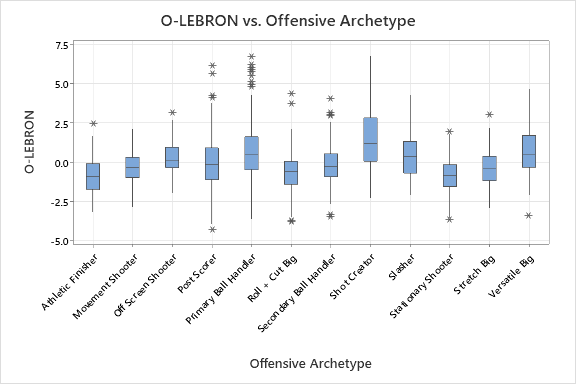
There’s a mountain of evidence that O-LEBRON views Shot Creators [2] are the most valuable offensive players. They’re worth +1.56 points per 100 possessions on average, and interestingly post the highest standard deviation in its values among all archetypes. Not only do these players tend to provide lots of value, but the best of the best Shot Creators are also able to separate themselves from their peers unlike any archetype. Primary Ball-Handlers are the most similar, with the difference in their archetype being a lower rate of isolation scoring.
Movement Shooters and Off-Screen Shooters sound similar, yet the latter has a visible advantage. What’s the difference? Movement Shooters are mostly identified by their three-point rate, while Off-Screen Shooters have a higher proportion of scoring coming off screens or hand-offs. Interestingly, Movement Shooters cost their teams 0.3 points per 100 on average, while Off-Screen Shooters add 0.2 points on average.
Athletic Finishers and Slashers seem to have overlap. Yet, once again, the latter has a visible advantage. So what’s this difference? Athletic Finishers are characterized by their activity on cuts and putbacks, whereas slashers are determined by their three-point rates and drives per possession. Athletic Finishers were the least valuable archetype on average, costing 0.9 points per 100. Slashers, on the other hand, were the fourth-most valuable, adding 0.4 points per 100.
Post Scorers and Stretch Bigs are on opposite ends of the basketball timeline. The latter is seen as more progressive, yet Post Scorers are still more valuable according to LEBRON. They’re worth about 0.3 points more than Stretch Bigs per 100, and their distribution reaches higher. Meanwhile, Versatile Bigs tend to be more valuable than both! They can post up, shoot threes, roll to the basket, and are supposed to have more well-rounded skill sets.
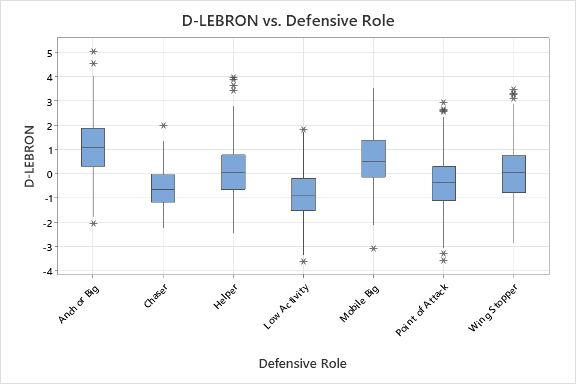
Like Shot Creators for offense, Anchor Bigs appear to be the most valuable archetypes on defense. They are seen as less mobile, and tend to drop against shooters to defend the pick-and-roll. They also tend to not have very versatile matchups compared to other archetypes. Basically all of the all-time great defenders in the LEBRON era have been Anchor Bigs. Mobile Bigs trail as the “second-most valuable,” and these players tend to hedge screens and switch more heavily compared to Anchor Bigs. They’re worth 0.6 points per 100 on average.
POA’s and Wing Stoppers are both perimeter-oriented defenders. POA’s often defend opposing Ball-Handlers, whereas Wing Stoppers defend Shot Creators. POA’s have higher rates of matchup versatility, whereas Wing Stoppers have more responsibilities off-ball, switching, et cetera. Both archetypes are about neutral defenders on average, with the best Wing Stoppers reaching higher than the best POA’s.
Chasers and Helpers are both archetypes that involves lots of movements and court coverage. Chasers stick to shooters and cutters near the perimeter while Helpers are savvy rotators who provide resistance at the rim. Helpers are observably more valuable on average, and have reached far greater heights than the best Chasers.
Low Activity defenders are best known for their communication abilities when engaged, but otherwise provide little value in defending actions and matchups. They are, unsurprisingly, almost always value-losses.
Interpretation
Based on the differences between Primary Ball-Handlers and Shot Creators, there may be an indicator that (at least, for guards) isolationism is more valuable than pick-and-roll actions. As observed, Primary Ball-Handlers can still be some of the very best offensive players in the league, but the evidence suggests isolation scoring is typically more valuable, and that pick-and-roll ball-handlers likely have to be very, very good at what they do to reach those heights.
There’s also an absence of the assessment of passing quality in these archetypes. I’m compelled to believe passing bleeds into both of the above archetypes. Isolation scoring on its own is not very “valuable,” since it rarely adds more than 1.1 points per possession on average. For teams to exceed the league average of 1.13 in these years, they need higher-quality shots. As has been observed, isolation scorers who can pass to open teammates provide a dual threat that is unmatched by most any players. Perhaps that is why Primary Ball-Handlers can still reach the top of the O-LEBRON leaderboards. They create a ton of shots at the rim in the pick-and-roll without a massive scoring punch.
The differences between Movement and Off-Ball Shooters could be a commentary on “teamwork.” Perhaps the quality of a player’s looks when his teammates are involved in getting him open. Teams employ screens for obvious reasons: to stunt defenders. Players who make timely cuts also exploit defensive inattention. Movement, while it stretches the defense, likely isn’t on its own a large value-add. There needs to be some predication, an action that prohibits defenses from guarding tightly.
Athletic Finishers are clearly less valuable than Slashers despite similar damage at the rim. There’s something to be said geometrically, where players who pressure the rim with drives rather than scoring on second-chance opportunities are greater advantage creators. They can pass out of these spots, and their on-ball threat to score draws defensive attention in a more looming way than cutters. This is another instance in which the value of the scoring-passing combination seems to bleed through.
Big who stretch the floor are “less bad” than the worst Post Scorers, but they don’t provide the higher levels of value that the best Post Scorers do. This could have something to do with scoring around the rim, whereas bigs who draw attention to the perimeter are “always” providing a geometric effect that Post Scorers often don’t. But it’s clear that a combination of the two is best, and that bigs pretty much need to score at the rim at a decent clip to ascend offensively.
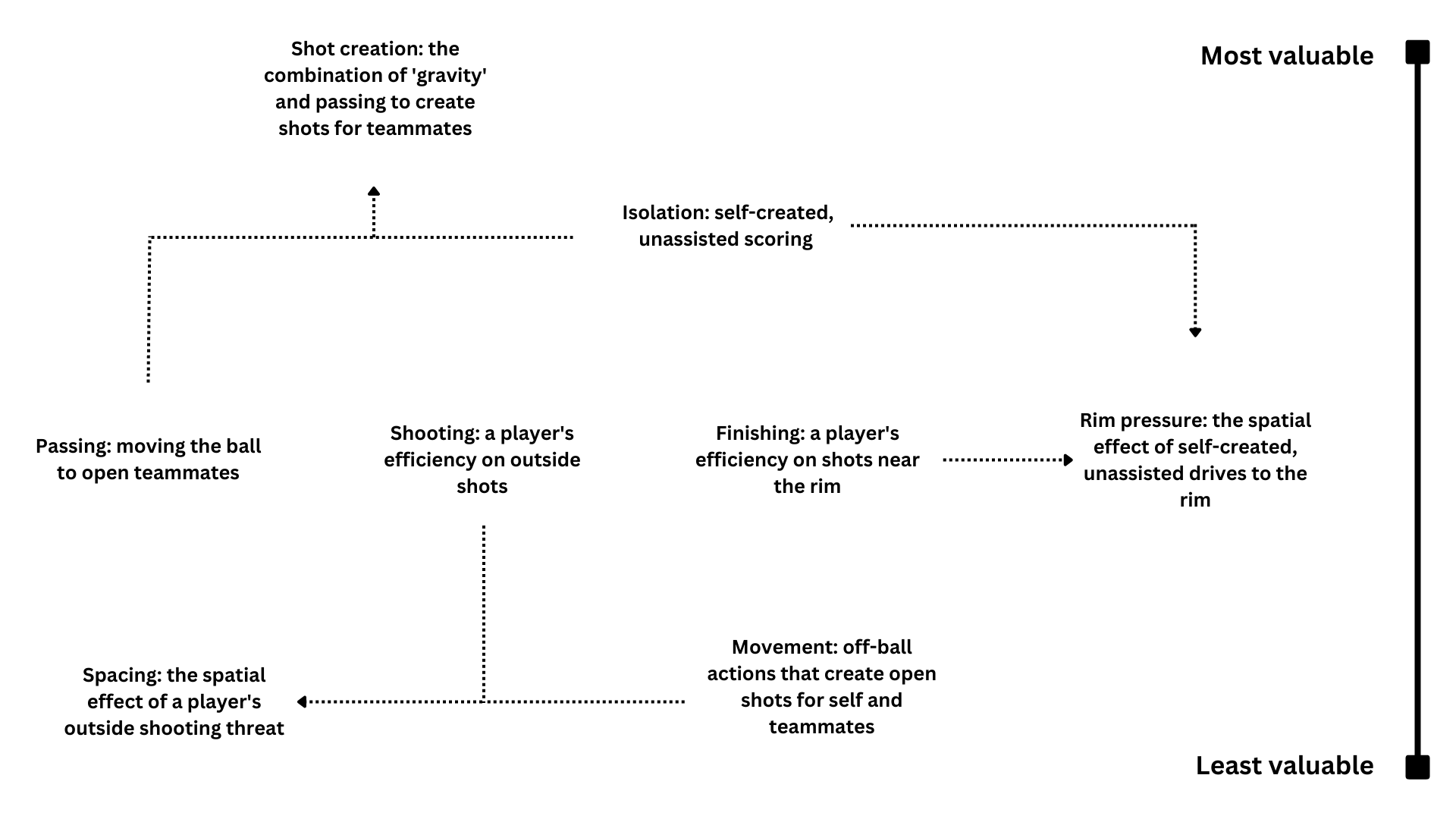
Defensively, the value of rim protection is Obvious with a capital “O.” There’s the narrative that shots at the rim are most efficient, so defenders who can not only sway them but deter them are most valuable. This seems true. Bigs who hedge screens may pose the risk of blow-bys and more shots at the rim, which might explain their decrease in value despite a more versatile skill set. Regardless, these defenders can still be really good by fizzling out perimeter actions while providing occasional paint resistance. But rim protection on its own seems to remain the gold standard for best-of-the-best defense.
Because one-on-one basketball tends to not yield great results, POA defenders aren’t super valuable. (Especially if they don’t provide skills elsewhere in deterring high-quality shots.) It’s the defensive equivalent to decent isolation scorers who can’t pass. Unless they reach a certain threshold for efficiency and passing, they’re not really doing much. Therefore, as the data suggests, there’s more value in defending Shot Creators whose skills demand off-ball awareness. Helping, switching, and resisting on the perimeter are noticeably more valuable.
Chasers are the antithesis to the “Movement” offensive skill, so it’s no surprise they are rarely positive defenders. (Again, especially if they don’t provide value in other areas.) But there have been some great Helper defenders in recent years. They are paramount paint defenders like bigs, but the positioning and switching that comes with the role does provide ancillary rim protection.
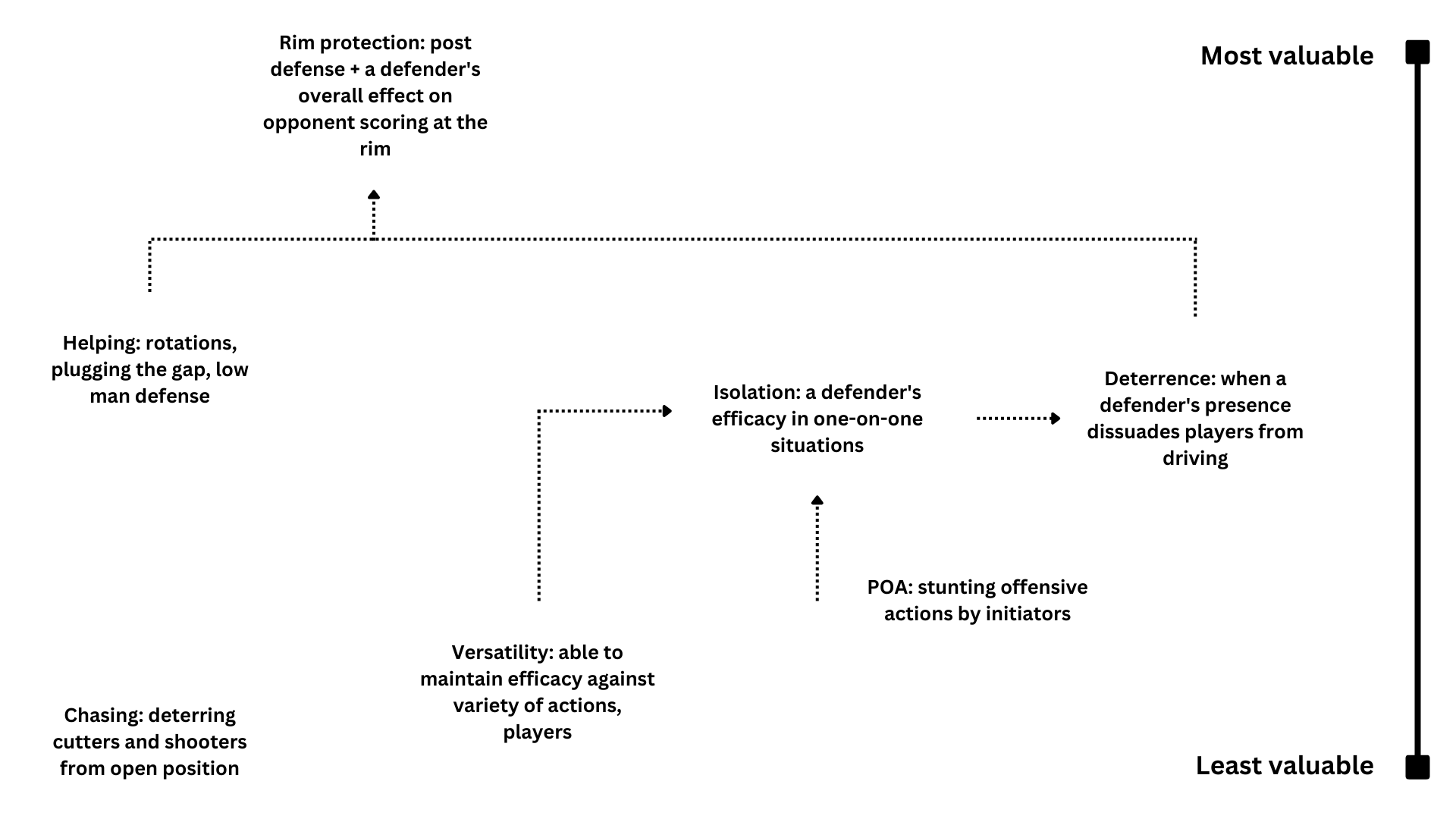
Footnotes
[1] Note that offensive archetypes and defensive roles aren’t based on “how well” a player carries out his role, but solely what that role is.
[2] “Shot Creator: players in this offensive role are non-Bigs that we identify as have high rates of perimeter and interior isolation rates, creating their own shots within the offense as a key skill set. Examples from 2019-20 are Luka Doncic and James Harden” (BBall-Index).
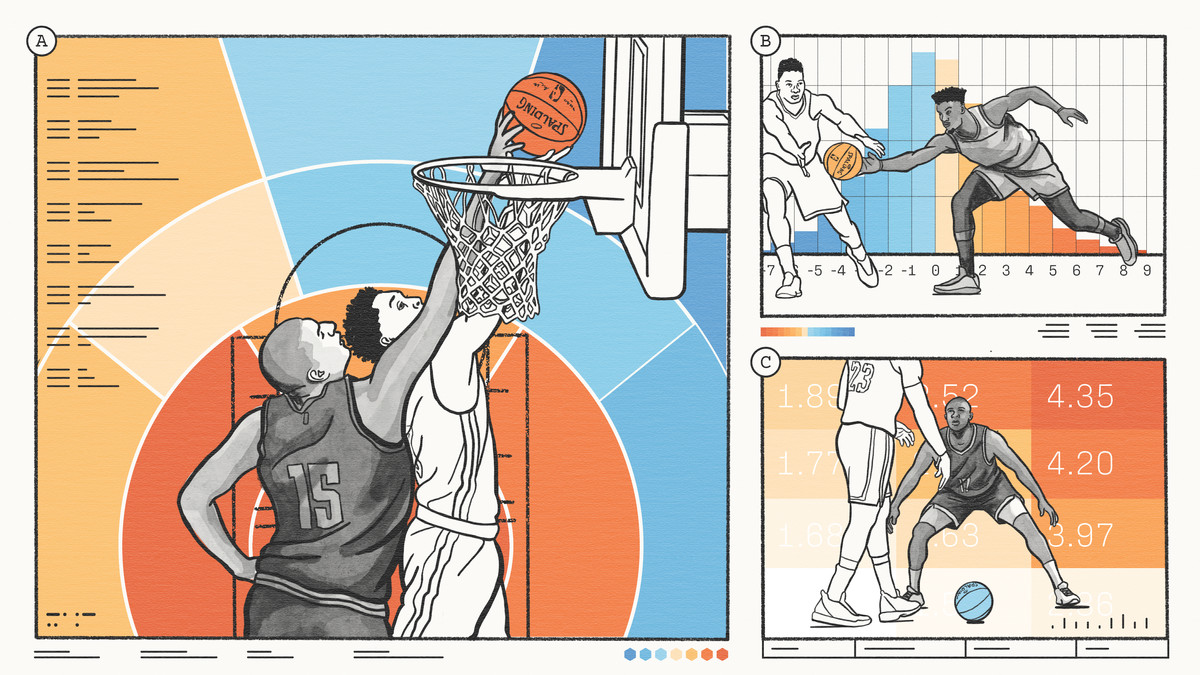
Leave a Reply